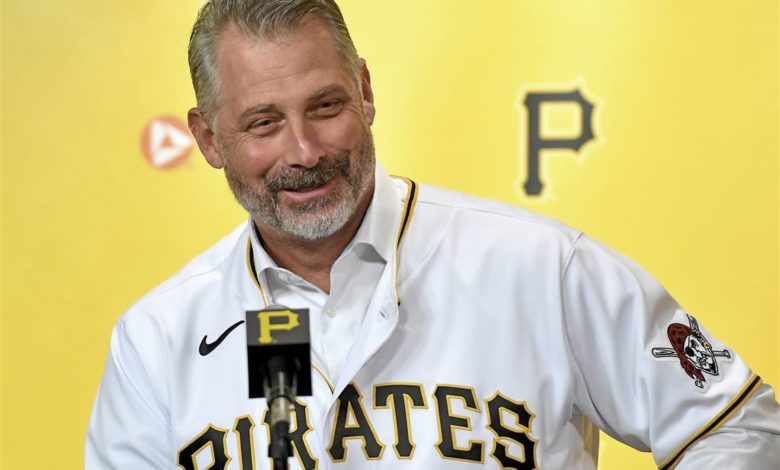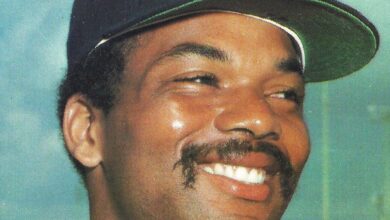
Lost in the Pittsburgh Pirates’ start to this season is manager Derek Shelton‘s creative use of his top relief pitcher, David Bednar. As I write this, 33 games in, Bednar has appeared in 14 games, earning six saves and four “holds.” He’s entered the game in the ninth inning only five times. Twice he’s come into the game in the seventh inning. He has two two-inning saves and a four-out save to his credit. On other teams, the hard-throwing Bednar might be used in what’s become the traditional role of the “closer,” entering games only in ninth-inning save situations. Shelton, however, has used Bednar in critical situations in earlier innings, sometimes with men on base. This has left some save opportunities for Chris Stratton. The strategy is working. The Pirates are 11-3 in games in which Bednar has appeared. But is Shelton’s “new school” use of Bednar really so new?
The firemen
I grew up watching the Pirates in the pre-closer era, when a team’s top reliever was called a “fireman.” I remember Al McBean, Dave Giusti, Rich Gossage and Kent Tekulve entering games for the Pirates as early as the sixth or seventh inning, often with men on base, to “put out the fire.” I’m just barely too young to have memories of Roy Face but I heard plenty about him. It wasn’t unusual for any of these gentlemen to earn a multi-inning save, or come into a game when the Pirates were losing or tied, in the hope they could keep the opposition from adding any more runs and give their team the best chance to come back and win. Sometimes this meant somebody else on the staff might come in later and get the save. It wasn’t looked upon as heresy. It was smart baseball.
The closer
April 3, 1987. That was the day the Oakland Athletics acquired Dennis Eckersley from the Chicago Cubs for three minor leaguers. I hate to think my 29th birthday also was the anniversary of the evil alliance between Eckersley and manager Tony La Russa, which spawned the closer and led to constant late-inning pitching changes and longer games. At that point, Eckersley was a 12-year starter with a 151-128 career record. But at age 31, he had had a rough 1986 with the Cubs. La Russa soon saw “Eck” could be useful as a one-inning reliever, limiting him to ninth-inning save opportunities. Eckersley led the major leagues with 45 saves in 1988 and would finish his career with 390 saves.
The A’s would win three American League pennants and one World Series from 1988-90. Naturally, La Russa’s bullpen philosophy would be copied by every other major-league team. Each team soon had a closer whose duty was limited to ninth-inning save situations. The closers enjoyed racking up save stats, which helped them at contract time. Managers, too, seemed to enjoy being immune to second-guessing whenever the closer blew a lead.
Start making sense
But in reality, how much sense did this make from a baseball standpoint? My son and I had Tekulve all to ourselves for about a half hour in 1998 during a promotional appearance. When I asked his opinion about how the closer’s role had evolved, he said (and I paraphrase), Managers aren’t giving themselves the best chance to win games. Maybe the middle of the order is up in the eighth inning. When I pitched, I knew I had to be ready to come into the game from the seventh inning on if we were winning by three, losing by two, or anything in between. I’d finish the year with around 10 wins in addition to my saves. Today the closer might finish with a record of something like 1-9. He either gets the save or loses the game.
The numbers
Indeed, doing my own deep dive into the numbers over these past few years, it seemed ridiculous to me that the closer, ostensibly a team’s best relief pitcher, often ranked toward the bottom on his team in innings pitched. I compiled the following table where I selected a few years and examined the stats of the Pirates’ closers. Note the sharp decrease in wins and innings pitched beginning in 1988.
| Year | Name | W-L | Saves | IP | Rank on team |
| 1960 | Roy Face | 10-8 | 24 | 114.2 | 5th |
| 1961 | Roy Face | 6-12 | 17 | 92 | 7th |
| 1962 | Roy Face | 8-7 | 28 | 91 | 7th |
| 1964 | Al McBean | 8-3 | 21 | 89.2 | 6th |
| 1965 | Al McBean | 6-6 | 19 | 114 | 5th |
| 1970 | Dave Giusti | 9-3 | 26 | 103 | 6th |
| 1971 | Dave Giusti | 5-6 | 30 | 86 | 8th |
| 1977 | Rich Gossage | 11-9 | 26 | 133 | 5th |
| 1978 | Kent Tekulve | 8-7 | 31 | 135.1 | 5th |
| 1979 | Kent Tekulve | 10-8 | 31 | 134.1 | 6th |
| 1982 | Kent Tekulve | 12-8 | 20 | 128.2 | 5th |
| 1988 | Jim Gott | 6-6 | 34 | 77.1 | 7th |
| 1989 | Bill Landrum | 2-3 | 26 | 81 | 8th |
| 1998 | Rich Loiselle | 2-7 | 19 | 55 | 10th |
| 2002 | Mike Williams | 2-6 | 46 | 61.1 | 12th |
| 2004 | Jose Mesa | 5-2 | 43 | 69.1 | 9th |
| 2005 | Jose Mesa | 2-8 | 27 | 56.2 | 11th |
| 2008 | Matt Capps | 2-3 | 21 | 53.2 | 10th |
| 2009 | Matt Capps | 4-8 | 27 | 54.1 | 8th |
| 2011 | Joel Hanrahan | 1-4 | 40 | 68.2 | 9th |
| 2012 | Joel Hanrahan | 5-2 | 36 | 59.2 | 9th |
| 2013 | Jason Grilli | 0-2 | 33 | 50 | 13th |
| 2015 | Mark Melancon | 3-2 | 51 | 76.2 | 6th |
| 2018 | Felipe Vazquez | 4-2 | 37 | 70 | 8th |
The closer as specialist
Soon managers would speak of closing a game as if it were a specialty that few could master. This comment by then-Tigers manager Brad Ausmus, speaking to FanGraphs on June 14, 2017, was typical: “A lot of people in the analytics world think you should bring in your best pitcher in the biggest point of the game. Well, excuse my French, but who the (bleep) knows when the biggest point in the game is until the game is over? You don’t know. It may be the sixth. It may be the ninth. The problem is, if it’s the sixth and you use your closer, and all of a sudden you have a one-run lead in the ninth, who is going to close? You don’t have that guy anymore, because you burned him. . . . closing a game in the ninth inning is not the same as pitching the eighth inning, or the seventh inning.”
I don’t pretend to know as much baseball as Ausmus or any other major-league manager. Still, I have a hard time imagining there are pitchers in the majors who’d wet their pants at the prospect of pitching the ninth inning. I would think a more typical attitude could be found in the words of Jason Grilli. In 2013, he went from eighth-inning specialist to the Pirates’ closer. Discussing the matter in his book, Just My Game, he said, “About 98 percent of the time, the eighth-inning guys face the heart of the order, and based on my track record, it was clear that I had few problems with those guys, so it would make sense that I could handle numbers six, seven and eight and close out games.”
More specialists
Eventually teams had seventh- and eighth-inning specialists as well. Jim Tracy took the concept to absurd lengths during his forgettable 2006-07 tenure as Pirates manager. On May 19, 2007 in PNC Park, the Pirates led the Arizona Diamondbacks, 7-3, in the seventh inning. With two outs and the bases loaded, Robby Hammock, a right-hander batting .259 at the time, was due up. Waiting in the wings to pinch hit was power-hitting switch-hitter Tony Clark. The situation screamed for eighth-inning specialist Matt Capps.
But this was the seventh inning. Tracy summoned Marty McLeary, a career minor leaguer who’d been hit hard in mop-up duty and sported a 7.36 ERA. McLeary surrendered a demoralizing, game-tying grand slam to Clark. The Pirates would eventually lose, 9-8. The next afternoon during his pregame radio interview, Tracy explained that he went to McLeary because he couldn’t use Capps to get four outs. Since he needed only one out to escape the seventh, it was a baffling explanation, to say the least. The implication was Capps was coming in only if he were going to pitch the eighth as well.
No specialists
Clint Hurdle took over as Pirates manager in 2011 and employed closers and eighth-inning specialists like all the other teams. In 2017, the closer’s job went to Tony Watson, who was removed from the role in June. The title then went to Felipe Vazquez (then known as Felipe Rivero). Hurdle said Vazquez would not be limited to ninth-inning save situations. Hurdle cited the Cleveland Indians’ Andrew Miller, then arguably the best and most valuable reliever in baseball, who frequently entered games early, with men on base. (Miller appeared in 57 games in 2017, recording the final out in only six of them.)
On June 16 against the Chicago Cubs, the Pirates enjoyed a 4-3 lead after seven. With the top of the Cubs’ batting order due up in the eighth, Hurdle went to Vazquez, who faced four batters and disposed of them without a run scoring. Because Vazquez threw 20 pitches, however, Hurdle turned to Juan Nicasio for the ninth. Nicasio surrendered two doubles, a single and an intentional walk without retiring a batter. Watson relieved him and fared no better, and the Pirates lost, 9-5.
Breaking up the closer’s role is hard to do
Hurdle had made the right move. Nicasio had to be able to get through the bottom of the order unscathed. If it wasn’t his day, he likely would have trouble in the eighth as well. Even so, the media and talk show callers went crazy. Hurdle didn’t save his closer for the ninth inning! Hurdle told the media, “So the fact we didn’t have success with it one time [means] we kick it to the curb? We’d still like to use Felipe in what we believe at the time is the most meaningful part of the game.”
Yet kicking it to the curb was exactly what Hurdle did. Vazquez appeared in 38 more games in 2017, entering as early as the eighth inning only eight times, finishing the game each time. It’s good to see Shelton sticking with the strategy, critics be damned.
The opener
In 2018, the Tampa Bay Rays came up with the intriguing idea of using closer Sergio Romo as an “opener.” He pitched only the first inning on three occasions and the first two on two others. What was the rationale? Well, the first inning is the only inning where the batting order lines up the way the opposing manager intended, and the team that scores first wins roughly two-thirds of the time, so why not use your best relief pitcher at the start?
Hurdle toyed with the idea of using an opener in 2019 without great success. Rather than use his top reliever Vazquez in the role, however, at different times he employed Montana DuRapau, Michael Feliz and Rookie Davis, whose major-league careers were defined mostly by struggles. This season, Shelton has used Dillon Peters as an opener, with better results. The Pirates are 1-2 in the three games Peters has started. But he didn’t surrender any runs in any of those starts and the Pirates gave up only three runs in each of the two losses. Again, Shelton’s use of the opener isn’t so new. It dates back further than one would think.
The opener before the opener
The Pirates had used an opener long before the Rays thought of it. It was game six of the 1990 National League Championship Series against the Cincinnati Reds. The Pirates were down, three games to two, in the best-of-seven series. Lefty Zane Smith had been announced as the starter. On game day, manager Jim Leyland switched to right-handed reliever Ted Power, who pitched into the third inning before giving way to Smith. The ploy worked as intended, as it caused Reds manager Lou Piniella to alter his batting order, and the Reds were held to just two runs. But the Pirates could only manage one run and lost the series.
The most unusual save
I can’t write about the save without discussing my favorite save, one that didn’t even count as a save. It was in 1952, when the Cardinals’ Stan Musial and the Cubs’ Frank Baumholtz were ranked one and two for the National League batting title heading into the final game of the season. It just so happened the teams were playing one another in St. Louis. Baumholtz had just a slim chance of catching Musial. One time at bat without a hit and he was out of contention. Cardinals starter Harvey Haddix walked the lead-off batter in the first inning. With Baumholtz due up next, Cardinals manager Eddie Stanky strolled to the mound, signaling for a left-handed reliever. But he wasn’t signaling the bullpen. He signaled center field, where Musial was stationed. Musial then switched places with Haddix.
Musial pitched three years in the minors, where he compiled a 33-13 record, but was pitching for his first and only time in the majors. Baumholtz reached on an error, which of course counted as a time at bat but not a hit. Musial then returned to center field, his major-league pitching career now over for good. The season ended with Musial as the batting champ. Although he later regretted participating in the stunt, Musial the pitcher recorded the most unusual save of all, saving his own batting title. Now that’s what I call a save!





